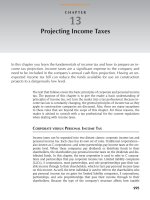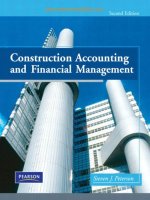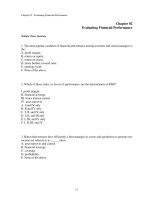Construction Financial Management Solutions
Bạn đang xem bản rút gọn của tài liệu. Xem và tải ngay bản đầy đủ của tài liệu tại đây (2.84 MB, 50 trang )
ConstructionFinancialManagement:
Solutions
S.L.Tang
Downloadfreebooksat
S.L. Tang
Construction Financial Management
Answers to Exercise Questions
2
Download free eBooks at bookboon.com
Construction Financial Management: Answers to Exercise Questions
1st edition
© 2015 S.L. Tang & bookboon.com
ISBN 978-87-403-0949-2
3
Download free eBooks at bookboon.com
Construction Financial Management:
Answers to Exercise Questions
Contents
Contents
Exercise Questions for Chapter 1
5
Exercise Questions for Chapter 2
7
Exercise Questions for Chapter 3
12
Exercise Questions for Chapter 4
21
Economic indicator NPV and inancial indicator IRR
24
Exercise Questions for Chapter 5
31
Exercise Questions for Chapter 6
36
Exercise Questions for Chapter 7
40
Exercise Questions for Chapter 8
44
www.sylvania.com
We do not reinvent
the wheel we reinvent
light.
Fascinating lighting offers an ininite spectrum of
possibilities: Innovative technologies and new
markets provide both opportunities and challenges.
An environment in which your expertise is in high
demand. Enjoy the supportive working atmosphere
within our global group and beneit from international
career paths. Implement sustainable ideas in close
cooperation with other specialists and contribute to
inluencing our future. Come and join us in reinventing
light every day.
Light is OSRAM
4
Download free eBooks at bookboon.com
Click on the ad to read more
Construction Financial Management:
Answers to Exercise Questions
Exercise Questions for Chapter 1
Exercise Questions for Chapter 1
Exercise Question 1
Using the company balance sheet shown on Table 2.2 of Chapter 2, calculate for each 2012 and 2011:
a) the company’s equity (or net worth),
b) working capital, and
c) current ratio.
Solution:
(a) Company’s equity (or net worth)
Total assets
2012
2011
14,591,105
13,772,652
9,159,760
8,078,450
5,431,345
5,694,202
Total liabilities
Net worth
(b) Working capital
2012
Current assets
2011
12,697,745
11,685,952
Current liabilities
7,679,247
6,177,005
Working Capital
5,018,498
5,508,947
(c) Current ratio
2012
Current assets
12,697,745
=
Current liabilities
2011
11,685,952
= 1.65
7,679,247
= 1.89
6,177,005
Exercise Question 2
Based on the project data presented in the table below, calculate for each of the two projects:
a) the revenue using the percentage-of-completion method,
b) the gross proit to date, using the percentage-of-completion method, and
c) the amount of over / under billing for each project.
5
Download free eBooks at bookboon.com
Construction Financial Management:
Answers to Exercise Questions
Exercise Questions for Chapter 1
Project
Financial data
Project A
Project B
Contract amount
$15,000,000
$15,000,000
Original estimated cost
14,400,000
14,800,000
Amount billed to date
10,700,000
10,700,000
Payments received to date
10,900,000
10,630,000
Cost incurred to date
11,450,000
10,550,000
Forecasted cost to complete
3,000,000
4,100,000
Costs paid to date
9,400,000
9,600,000
Note: some igures are for reference only and are not useful for calculating what are asked for
Solution:
(a) Revenue using the percentage-of-completion method
Project A
Cost incurred
% completed =
Project B
11,450,000
10,550,000
14,450,000
14,650,000
79%
= 72%
=
Cost incurred + forecasted cost
=
Project A
Revenue = Contract Amount × % completed =
15,000,000 × 79%
15,000,000 × 72%
= 11,850,000
= 10,800,000
(b) Gross Proit using the percentage-of-completion method
Project A
Project B
Revenue
11,850,000
10,800,000
Cost incurred
11,450,000
10,550,000
400,000
250,000
Gross Proit
Project B
(c) Under billing
Project A
Project B
Revenue
11,850,000
10,800,000
Amount billed
10,700,000
10,700,000
Under-billing
1,150,000
100,000
6
Download free eBooks at bookboon.com
Construction Financial Management:
Answers to Exercise Questions
Exercise Questions for Chapter 2
Exercise Questions for Chapter 2
Exercise Question 1
Base on the Income Statement and the Balance Sheet shown on Tables 2.1 and 2.2 respectively in
Chapter 2. Calculate:
a) the three Proitability Ratios,
b) the three Liquidity Ratios,
c) the three Working Capital Ratios,
d) the two Capital Structure Ratios, and
e) the seven Activity Ratios.
Solution:
(a) Proitability Ratios
Proitability ratios measure the construction company’s ability to earn proit from its operation. he
three most commonly used proitability ratios are:
Gross Proit Margin Ratio = Gross proit / Revenue
For 2012, 9,921,256 / 40,875,351 = 24.27%
For 2011, 10,319,606 / 34,701,250 = 29.74%
(he goal for net proit margin ratio is 25% minimum; if subcontractors (pay-as-paid basis) occupy a
signiicant portion of the cost of revenue, the goal can be reduced to 20% minimum)
Net Proit Margin Ratio = Net proit before tax / Revenue
For 2012, 1,333,440 / 40,875,351 = 3.26%
For 2011, 2,814,730 / 34,701,250 = 8.11%
(he goal for net proit margin ratio is 5% minimum)
Return on Equity Ratio = Net proit before tax / Owners’ equity
For 2012, 1,333,440 / 5,431,345 = 24.55%
For 2011, 2,814,730 / 5,694,202 = 49.43%
(he return on equity ratio should be between 15% and 40%)
7
Download free eBooks at bookboon.com
Construction Financial Management:
Answers to Exercise Questions
Exercise Questions for Chapter 2
(b) Liquidity Ratios
Liquidity ratios indicate the construction company’s ability to pay its obligations as they come due. he
three most common liquidity ratios used are shown below.
Current Ratio = Current assets / Current liabilities
For 2012, 12,697,745 / 7,679,247 = 1.65
For 2011, 11,685,952 / 6,177,005 = 1.89
(he current ratio should be higher than 1.3 for a inancially healthy construction company)
Acid Test Ratio (or Quick Ratio) = (Cash + Accounts receivables) / Current liabilities
For 2012, (2,305,078 + 6,124,992) / 7,679,247 = 1.10
For 2011, (1,877,676 + 5,837,658) / 6,177,005 = 1.25
(he acid test ratio or quick ratio should be higher than 1.1 for a construction company)
Current Assets to Total Assets Ratio = Current assets / Total assets
For 2012, 12,697,745 / 14,591,105 = 87.02%
For 2011, 11,685,952 / 13,772,652 = 84.85%
(he current assets to total assets ratio should be between 60% and 80%)
(c) Working Capital Ratios
hese ratios measure how well the construction company is utilizing its working capital. he three most
commonly used working capital ratios are shown below.
Working Capital Turnover = Revenue / Working capital
For 2012, 40,875,351 / (12,697,745 – 7,679,247) = 8.14 times
For 2011, 34,701,250 / (11,685,952 – 6,177,005) = 6.30 times
(he working capital turnover should be between 8 and 12 times per year)
Net Proit to Working Capital Ratio = Net proit before tax / Working capital
For 2012, 1,333,440 / (12,697,745 – 7,679,247) = 26.57%
For 2011, 2,814,730 / (11,685,952 – 6,177,005) = 51.09%
(he net proit to working capital ratio should be between 40% and 60%)
8
Download free eBooks at bookboon.com
Construction Financial Management:
Answers to Exercise Questions
Exercise Questions for Chapter 2
Degree of Fixed Asset Newness = Net depreciable ixed assets / Total depreciable ixed assets
For 2012, 1,893,360/ 3,945,260 = 47.99%
For 2011, 2,086,700/ 3,750,100 = 55.64%
(he degree of ixed asset newness should be between 40% and 60%)
(d) Capital Structure Ratios
Capital structure ratios indicate the ability of the construction company to manage liabilities. hese
ratios also indicate the approach that the company prefers to inance its operation. he two major capital
structure ratios are:
Debt to Equity Ratio = Total liabilities / Owners’ equity
For 2012, 9,159,760 / 5,431,345 = 1.69
For 2011, 8,078,450 / 5,694,202 = 1.42
(he debt to equity ratio should be lower than 2.5)
Leverage = Total assets / Owners’ equity
For 2012, 14,591,105 / 5,431,345 = 2.69
For 2011, 13,772,652 / 5,694,202 = 2.42
360°
thinking
.
Discover the truth at www.deloitte.ca/careers
9
Download free eBooks at bookboon.com
© Deloitte & Touche LLP and affiliated entities.
Click on the ad to read more
Construction Financial Management:
Answers to Exercise Questions
Exercise Questions for Chapter 2
Or
Leverage
= Total assets / Owners’ equity
= (Total liabilities + Owners’ equity) / Owners’ equity
= (Total liabilities / Owners equity) + 1
= Debt to Equity Ratio + 1
For 2012, 1.69 + 1 = 2.69
For 2011, 1.42 + 1 = 2.42
(he leverage should be lower than 3.5. Some construction companies prefer to use leverage of 3.5 or
close to it but some conservative ones prefer to use a lower leverage. his relates to, of course, the use
of a higher or lower debt to equity ratio by the company.)
(e) Activity Ratios
Activity ratios indicate whether or not the construction company is using its assets efectively, and if
yes, how efective they are. here are quite a number of activity ratios, and the seven commonly used
ones are shown below.
Average Age of Material Inventory = (Material inventory / Materials cost) × 365 days
For 2012, (942,765 / 20,732,506) × 365 = 16.60 days
For 2011, (761,763 / 15,925,567) × 365 = 17.46 days
(he average age of material inventory should be shorter than 30 days)
Average Age of Under Billings = (Under billings / Revenue) × 365 days
For 2012, (581,221 / 40,875,351) ×365 = 5.19 days
For 2011, (486,472 / 34,701,250) × 365 = 5.12 days
(he average age of under billings should be the shorter the better)
Average Age of Accounts Receivable = (Accounts receivable / Revenue) × 365 days
For 2012, (6,124,992 / 40,875,351) × 365 = 54.69 days
For 2011, (5,837,658 / 34,701,250) × 365 = 61.40 days
(he average age of accounts receivable should be shorter than 45 days)
10
Download free eBooks at bookboon.com
Construction Financial Management:
Answers to Exercise Questions
Exercise Questions for Chapter 2
Cash Conversion Period = Average age of material inventory + Average age of under billings + Average
age of accounts receivable
For 2012, 16.60 + 5.19 + 54.69 = 76.48 days
For 2011, 17.46 + 5.12 + 61.40 = 83.98 days
(he cash conversion period should be shorter than 75 days)
Average Age of Accounts Payable = [Accounts payable / (Materials +Subcontracts)] × 365 days
For 2012, [3,930,309 / (20,732,506 + 6,417,407)] ×365 = 52.84 days
For 2011, [3,481,330 / (15,925,567 + 4,721,312)] × 365 = 61.54 days
(he average age of accounts payable should be shorter than 45 days)
Average Age of Over Billings = (Over billings / Revenue) × 365 days
For 2012, (560,847 / 40,875,351) × 365 = 5.01 days
For 2011, (495,167 / 34,701,250) × 365 = 5.21 days
(Usually there is no guideline on average age of over billings)
Cash Demand Period = Cash conversion period – Average age of accounts payable – Average age of
over-billings
For 2012, 76.48 – 52.84 – 5.01 = 18.63 days
For 2011, 83.98 – 61.54 – 5.21 = 17.23 days
(he cash demand period should be shorter than 30 days)
Exercise Question 2
By referring to the ratios calculated in Exercise Question 1 above, are there any things you would like
to add to Section 2.2 of the chapter to remind the new general manager that he has missed but should
have considered?
Solution:
his is an open-ended question, and is suitable for group discussion followed by presentation from
each group.
11
Download free eBooks at bookboon.com









